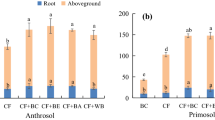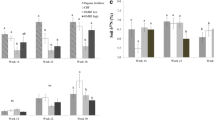Abstract
High concentrations of boron (B) and selenium (Se) naturally found in the environment are detrimental to sustainable agriculture in the western USA. Greenhouse pot experiments were conducted to study B and Se uptake in three different plant species; Brassica juncea (L.) Czern (wild brown mustard), Festuca arundinacea Schreb. L. (tall fescue), and Brassica napus (canola) were grown in soil containing naturally occurring concentrations of 3.00 mg extractable B kg−1 and 1.17 mg total Se kg−1 soil. During the growing season, four intermediate harvests were performed on wild mustard and tall fescue. Final harvest I consisted of harvesting wild mustard, canola, and clipping tall fescue. Final harvest II consisted of harvesting wild mustard, which had been planted in soil in which wild mustard was previously grown, and harvesting previously clipped tall fescue. The greatest total amount of above ground biomass and below surface biomass was produced by tall fescue. Plants were separated into shoots and roots, weighted, and plant tissues were analyzed for total B and Se. The highest concentrations of tissue B were recovered in shoots of wild mustard and canola at final harvest I, while roots from tall fescue contained the highest concentrations of B irrespective of the harvest. Tissue Se concentrations were similar in all plants species. Soils were analyzed for residual B and Se. Extractable soil B concentrations at harvest times were lowered no less than 32% and total Se no less than 24% for all three species. The planting of wild mustard, canola, or tall fescue can reduce water-extractable B and total Se in the soil.
Similar content being viewed by others
References
AubertH and PintaM 1977 Trace Elements in Soils. Elsevier Scientific Publishing Co., New York, pp 5–11.
Ayars J E, Hutmacher R B, Schoneman R A and S S Vail 1990 Long-term use of saline water for irrigation. Proc. Third National Irrigation Symposium, Phoenix, AZ, 28 Oct.–1 Nov. 1990. ASAE Publication 04–90. pp 368–373.
BańuelosG S, CardonG, PflaumT and AkohoueS 1992 Comparison of wet digestion and dry ashing of plant samples for boron analysis. Comm. Plant Soil Anal. 23, 17–20.
BańuelosG S, MeadR, WuL, BeuselinckP and AkohoueS 1992 Differential selenium accumulation among forage plant species from soils amended with selenium-enriched plant tissue. J. Soil Water Cons. 47, 338–342.
BańuelosG S and MeekD W 1990 Accumulation of selenium in plants grown on selenium treated soil. J. Environ. Qual. 19, 772–777.
Bingham F T 1982 Boron. In Methods of Soil Analysis. 2nd Ed. Eds. A L Page. pp 431–447. Agron. 9
BinghamF T, MarshA W, BransonR, MahlerR and FerryG 1972 Reclamation of salt affected high B soils in Western Kern County. Hilgardia 41, 195–211.
CaryE E, WieczorekG A and AllawayW H 1967 Reaction of selenite-selenium added to soils that produce lew selenium forages. Soil Sci. Soc. Am. Proc. 31, 21–23.
EatonF M 1944 Deficiency, toxicity, and accumulation of boron in plants. J. Agric. Res. 60, 237–277.
FlemingG A 1980 Essential micronutrients. I. Boron and Molybdenum. In: Applied Soil Trace Elements. Ed. B EDavies. pp 155–197. Wiley, New York.
FrankenbergerWJr and KarlsonU 1989 Environmental factors affecting microbial production of dimethylselenide in selenium-containing sediment, Soil Sci. Am. J. 53, 1435–1442.
Gissel-NielsenG, GuptaU C, LamM and WestermarkT 1984 Selenium in soils and plants and its importance in livestock and human nutrition. Adv. Agron. 37, 397–461.
GuptaU C 1968 Relationship of total and hot-water soluble B, and fixation of added B to properties of Podzol soils. Soil Sci. Soc. Am. Proc. 37, 45–48.
GuptaU C, JameY W, CampbellC A, LeyshonA J and NicholaichukW 1985 Boron toxicity and deficiency: A review. Can. J. Soil Sci. 65, 381–409.
Hoagland D R and Arnon D I 1950 Water culture method for growing plants without soil. Calif. Agric. Exp. Stn. Circ. 347.
KerenR and BinghamF T 1985 Boron in water, soils, and plants. In Advances in Soil Sciences, Vol. 1, pp 230–276. Springer-Verlag, New York.
KerenR, BinghamF T and RhoadesJ D 1985 Plant uptake of boron as affected by boron distribution between liquid and solid phases in soils. Soil Sci. Am. J. 48, 297–302.
KerenR and GastR G 1983 PH-dependent boron adsorption by montmorillonite hydroxy-aluminum complexes. Soil. Sci. Soc. Am. J. 47, 1116–1171.
KerenR and MezumanU 1981 Boron adsorption by clay minerals using a phenomenological equation. Clays, Clay Miner 29, 198–204.
KrauskopfK B 1973 Geochemistry of micronutrients. In Micronutrients in Agriculture. Eds. J JMortvedt, MGiordano and W LLindsay. pp 7–36. Soil Science Society of America, Madison, WI.
LewisB G 1976 Selenium in biological systems, and pathways for its volatilization in higher plants. (In) Environmental Biogeochemistry. Ed. J ONriaga. pp 389–409, Ann Arbor Sciences, Ann Arbor, MI.
MaasE V 1986 Salt tolerance of plants. Appl. Agric. Res. 1, 12–26.
MikkelsenR L, BinghamF T and PageA L 1988 Factors affecting selenium accumulation by agriculture crops. In Selenium in Agriculture and the Environment. Ed. L WJacob. pp 69–94. SSA Spec. Publ. 23 ASA and SSSA, Madison, WI.
National Research Council 1983 Selenium in Nutrition. National Academy of Sciences, Washington, DC.
NealR H, SpositoG, HoltzclawK M and TrainaS J 1987 Selenite adsorption on alluvial soils I. Soil composition and pH efects. Soil Sci. Soc. Am. J. 51, 1161–1165.
ParkerD R, PageA L and ThomasD N 1991 Salinity and boron tolerances of candidate plants for the removal of selenium from soils. J. Envir. Qual. 20, 157–164.
PeryeaF J, BinghamF T and RhoadesJ D 1985 Mechanisms for boron regeneration. Soil Sci. Soc. Am. J. 49, 840–843.
ReeveR C, PillsburyA J and WilcoxL V 1955 Reclamation of a saline and high B soil in the Coachella Valley of California. Hilgardia 24, 69–81.
RhoadesJ D, IngvalsonR D and HatcherJ J 1970 Laboratory determination of leachable soil boron. Soil Sci. Soc. Am. Proc. 34, 871–875.
RosenfeldI and BeathO A 1964 Selenium, Geobotany, Biochemistry, Toxicity, and Nutrition. Academic Press, New York.
SinghM, SinghN and RelanP S 1981. Adsorption and desorption of selenate and selenite on different soils. Soil Sci. 132, 134–141.
TanjiK 1970 A computer analysis on the leaching of B from stratified soil columns. Soil Sci. 110, 44–51.
WuL, HuangZ and BurauR G 1988 Selenium accumulation and selenium-salt co-tolerance in five grass species. Crop Sci. 28, 517–522.
Author information
Authors and Affiliations
Rights and permissions
About this article
Cite this article
Bańuelos, G.S., Cardon, G.E., Phene, C.J. et al. Soil boron and selenium removal by three plant species. Plant Soil 148, 253–263 (1993). https://doi.org/10.1007/BF00012862
Received:
Accepted:
Issue Date:
DOI: https://doi.org/10.1007/BF00012862




